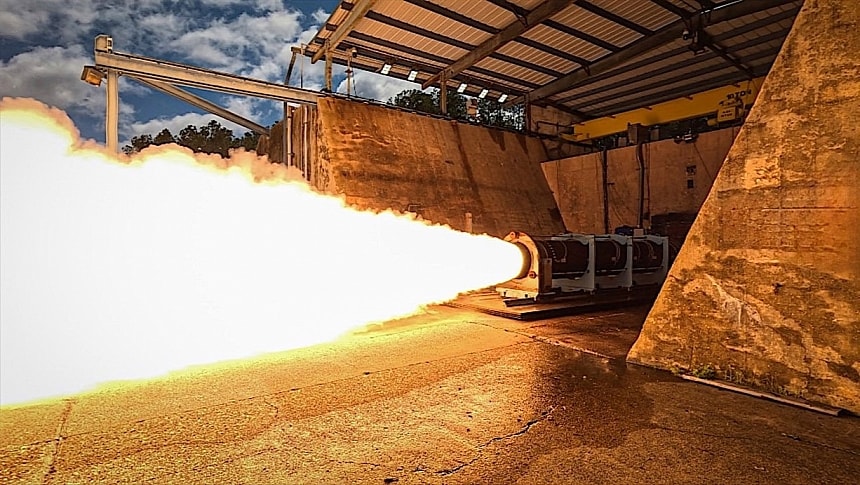It was back in June 2023 when we first got word of a new breed of solid rocket engine being in the works, and here we are less than a year later faced with the prospect of the engine's impending commercial use. Enter the Zeus.
Zeus is a design by American defense contractor Kratos, made with help from one of the most important names in the industry, Aerojet Rocketdyne. Its main role is to be used by Kratos' partners, including NASA and the U.S. Navy, to test stuff at hypersonic speeds on hypersonic vehicles.
The technology came into this world as Zeus 1, a 32.5-inch diameter rocket engine that was put through its paces last year at the Aerojet Rocketdyne facility in Arkansas. The tech worked, it seems, and Kratos let us know this week that the same happened with the Zeus 2, a version that was announced in 2023.
Both Zeus 1 and Zeus 2 are now past their static test-firing stage, and Kratos says the development stage is now over. The exact specifications of the rocket engine are not known, but the company making them promises better performance than what's currently being used and the same payload capacity.
On top of it all, the engine named after the king of the Gods are suitable to make use of existing infrastructure. It can however accommodate newer tech and more complex payloads, and can be flown more often, farther and faster than anything before it – again, Kratos does not provide numbers to back the claim.
The company does, however, provide one number, that of the number of Zeus engines it has orders for. A total of nine of them are being prepared for "upcoming customer flights" which could put through their paces hypersonic, ballistic, and sounding pieces of hardware.
The first use of the Zeus could be on a 3D-printed hypersonic drone called DART AE. Put together by Australian company Hypersonix, it is a 10-foot-long (three-meter) aircraft that weighs 661 pounds (300 kg). It usually uses a hydrogen-fuelled scramjet engine called Spartan, and in that configuration it should be able of reaching speeds of Mach 7 (5,370 mph/8,642 kph).
Kratos said in late summer 2023 that it would make Zeus engines for about 20 of these Australian drones, but no further updates have been provided since.
The American defense company plans to be a major player in this hypersonic market in the future. Aside from the Zeus, it is also working on a hypersonic test vehicle called Erinyes (which was first announced in 2021 and is expected to be shown as soon as this year). Another such aircraft, but one whose "nature and performance characteristics are highly confidential," is also in the works under the name Dark Fury.
The technology came into this world as Zeus 1, a 32.5-inch diameter rocket engine that was put through its paces last year at the Aerojet Rocketdyne facility in Arkansas. The tech worked, it seems, and Kratos let us know this week that the same happened with the Zeus 2, a version that was announced in 2023.
Both Zeus 1 and Zeus 2 are now past their static test-firing stage, and Kratos says the development stage is now over. The exact specifications of the rocket engine are not known, but the company making them promises better performance than what's currently being used and the same payload capacity.
On top of it all, the engine named after the king of the Gods are suitable to make use of existing infrastructure. It can however accommodate newer tech and more complex payloads, and can be flown more often, farther and faster than anything before it – again, Kratos does not provide numbers to back the claim.
The company does, however, provide one number, that of the number of Zeus engines it has orders for. A total of nine of them are being prepared for "upcoming customer flights" which could put through their paces hypersonic, ballistic, and sounding pieces of hardware.
The first use of the Zeus could be on a 3D-printed hypersonic drone called DART AE. Put together by Australian company Hypersonix, it is a 10-foot-long (three-meter) aircraft that weighs 661 pounds (300 kg). It usually uses a hydrogen-fuelled scramjet engine called Spartan, and in that configuration it should be able of reaching speeds of Mach 7 (5,370 mph/8,642 kph).
Kratos said in late summer 2023 that it would make Zeus engines for about 20 of these Australian drones, but no further updates have been provided since.
The American defense company plans to be a major player in this hypersonic market in the future. Aside from the Zeus, it is also working on a hypersonic test vehicle called Erinyes (which was first announced in 2021 and is expected to be shown as soon as this year). Another such aircraft, but one whose "nature and performance characteristics are highly confidential," is also in the works under the name Dark Fury.






